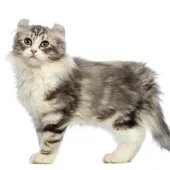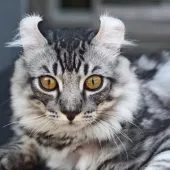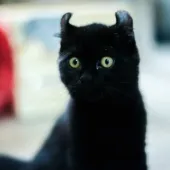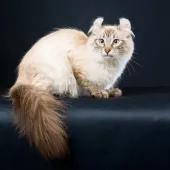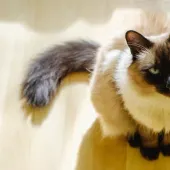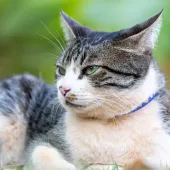The Graceful Curves of the American Curl: A Unique Feline Marvel
In the vast and varied world of cat breeds, the American Curl stands out as an elegant and distinctive feline companion. Renowned for its unique curled ears and affectionate nature, the American Curl cat breed has captured the hearts of cat lovers around the globe. Let's embark on a journey to unravel the enchanting qualities that make the American Curl a true marvel in the realm of domestic cats.
The Endearing Curl
The most striking feature of the American Curl cat is undoubtedly its ears. Unlike most cats, which have straight ears, the American Curl's ears are uniquely curled backward, creating an endearing and captivating appearance. This distinctive trait is a result of a genetic mutation that affects the cartilage in the cat's ears, giving them their signature curled look. The degree of curl can vary from a subtle curve to an elegant arc, adding to the individual charm of each American Curl cat.
A Gentle and Playful Nature
Beyond their distinctive ears, American Curl cats are beloved for their gentle and playful temperament. They are known for their affectionate nature, forming strong bonds with their human companions. These cats are sociable and enjoy being around people, making them excellent family pets. Their playful and curious personalities make them delightful companions for households with children, as they love interactive games and toys that challenge their intelligent minds.
Variety in Coat and Color
American Curl cats come in a variety of coat lengths and patterns. They can have either a short or longhaired coat, both of which are soft and silky to the touch. The breed exhibits a wide array of colors and patterns, including solid, tabby, bicolor, and more. This diversity in coat options allows cat enthusiasts to choose a Curl that matches their aesthetic preferences.
Health and Care
The American curl is a very healthy breed, mostly due to the large number of non-pedigreed domestic cats that helped to create the breed. Because of their propensity for ear infections, it's critical to maintain and clean their ears. Due to their unique ears, it's important to handle them gently to avoid causing any discomfort or injury. American curl cats, are also prone to progressive retinal atrophy, which can result in blindness.
Otherwise, simply keep an eye out for the common ailments that cats have as they age, such as :
- Osteoarthritis
- Feline Lower Urinary Tract Disease
- Hyperthyroidism
- Hypertrophic Cardiomyopathy
- Kidney Failure
American Curl cats are generally healthy, but like all cat breeds, they can be prone to certain genetic health issues. Responsible breeding practices can minimize the risk of hereditary conditions. Regular veterinary check-ups, a balanced diet, and regular exercise are essential for their overall well-being.
Cherished Companions
American Curl cats are not just pets; they are cherished companions that bring joy, warmth, and a touch of elegance to any home. Their distinctive appearance, coupled with their loving and playful nature, makes them a favorite choice among cat enthusiasts. Whether they are curling up in your lap or charming you with their playful antics, American Curl cats have a way of leaving an indelible mark on the hearts of those lucky enough to have them as part of their family.
Background and History
This cat found it simple to move up the success ladder. The Curl has succeeded in winning over judges and cat enthusiasts in the United States throughout its ten years of existence.
This breed was created in June 1981 when Grace Ruga of Lakewood, California, received two kittens that were neither identified by breed nor provenance. The cat's interestingly curled ears caught Grace's attention, and she chose to extend their visit. Every day, the two kittens would come for their supper and go at night.
Grace gave the kittens names based on marks in their fur: Panda and Shulamith, which she knew from the Bible to mean "black and comely." The day came when a strong wind suddenly blew Panda's door shut. The kittens had never been apart. While Shulamith happily settled into the Ruga household and gave her new human family her sisterly affection, Panda suffered a fatal head trauma.
Later, the kittens from Shulamith would give birth to kittens that shared the same trait of curled ears; one of the first females, Mercedes, was given to Grace's sister, Esther Brimlow of Orange, California. Nancy Kiester, a local butcher and cat enthusiast, noticed Mercedes and her kittens when she gave birth to a litter of her own shortly after. Kiester was so taken by the Curls that she set out to create the breed, starting when Mercedes's kittens produced a female and a male named Princess Leah and Master Luke, respectively.
Afterwards, Nancy got in touch with Grace and they started working together. In 1983, Nancy took Shulamith and the kittens to a cat show in California. The cat community responded by welcoming this endearing cat family with open arms. Working with breeder and judge Jean Grimm, who had been successfully producing Scottish Curls (or Folds), Nancy and Grace were able to establish that this was a completely distinct breed. The American Curl was born with her assistance when a name and standard were developed.
The International Cat Association (TICA) approved the American Curl's registration in 1987, and the TICA eventually granted the Curl championship status. There would be more success for it. The Curl was granted provisional status by the Cat Fancier's Association (CFA) in 1986. It was promoted to the CFA championship class in 1993.
The Curl is a highly sought-after breed due to its unique physical and personality characteristics, and it is recognized by all major cat groups. Given that Curl is a relatively new breed with a small gene pool, breeders have been encouraged to collaborate in an attempt to weave Curl to Curl bloodlines due to the breed's genetic variability. Even while outcross breeding will be permitted until 2010, it is more likely that the combined efforts of these breeders will produce a consistent Curl well ahead of the deadline.
Interesting Facts
The American Curl's ear curliness results from a genetic abnormality.
An American Curl's ear curls are the product of a dominant genetic mutation. Unlike recessive traits, which require the gene to be carried down from both parents for the feature to manifest, the trait is easily replicable because it manifests as long as the quality is passed down from one parent.- Among the newest cat breeds are American Curls.
The cat breed known as American Curls is very recent. They have only been recognized by the Cat Fanciers' Association since 1993, and the International Cat Association only acknowledged them in 1987. - The breed was unintentionally discovered.
The original American Curl, from whom all American Curls are descended, was a stray cat who was adopted by Joe and Grace Ruga in Lakewood, California. They went from poverty to wealth. The first cat with this genetic mutation to be identified was named Shulamith. We might not have learned about this mutation for many more years if the Rugas had not found her. - The CFA will only recognize the American curl as a breed in the longhair and shorthair classifications as of 2022.
- The most exacting standards are found in the ears of show cats. Cats whose ears curl either too much (beyond 180 degrees) or too little (at least 90 degrees) are not allowed to compete. Cats with ears that vary too much in curl from one ear to the other or lack sufficient firm cartilage at the base of their ears are also at risk.
It's hard to predict how much (or how little) a litter's ears will curl, even in curl-curl breedings. Within the same litter, kittens may have fairly deep curls or erect ears.
In conclusion, the American Curl cat breed exemplifies the beauty of uniqueness. Their curled ears and affectionate personalities make them a testament to the wonders of nature and the incredible diversity found within the feline world. As devoted and loving companions, American Curl cats continue to enchant cat lovers, reminding us of the magic that can be found in the simplest of gestures and the most unique of features.
